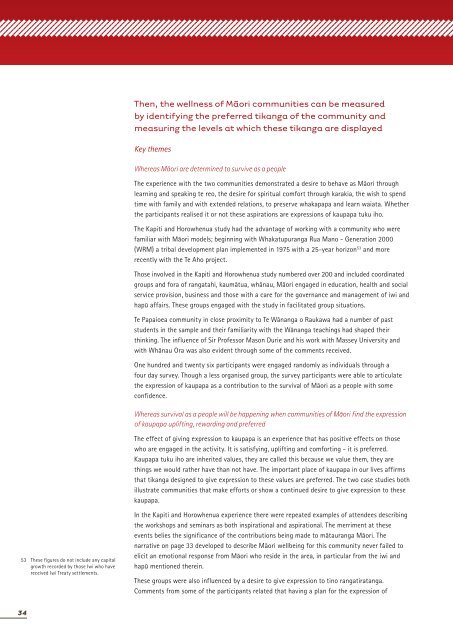He Oranga Hapori: A model for raising Maori ... - Te Puni Kokiri
He Oranga Hapori: A model for raising Maori ... - Te Puni Kokiri
He Oranga Hapori: A model for raising Maori ... - Te Puni Kokiri
- No tags were found...
You also want an ePaper? Increase the reach of your titles
YUMPU automatically turns print PDFs into web optimized ePapers that Google loves.
Then, the wellness of Māori communities can be measuredby identifying the preferred tikanga of the community andmeasuring the levels at which these tikanga are displayedKey themesWhereas Mäori are determined to survive as a peopleThe experience with the two communities demonstrated a desire to behave as Mäori throughlearning and speaking te reo, the desire <strong>for</strong> spiritual com<strong>for</strong>t through karakia, the wish to spendtime with family and with extended relations, to preserve whakapapa and learn waiata. Whetherthe participants realised it or not these aspirations are expressions of kaupapa tuku iho.The Kapiti and Horowhenua study had the advantage of working with a community who werefamiliar with Mäori <strong>model</strong>s; beginning with Whakatupuranga Rua Mano - Generation 2000(WRM) a tribal development plan implemented in 1975 with a 25-year horizon 53 and morerecently with the <strong>Te</strong> Aho project.Those involved in the Kapiti and Horowhenua study numbered over 200 and included coordinatedgroups and <strong>for</strong>a of rangatahi, kaumätua, whänau, Mäori engaged in education, health and socialservice provision, business and those with a care <strong>for</strong> the governance and management of iwi andhapü affairs. These groups engaged with the study in facilitated group situations.<strong>Te</strong> Papaioea community in close proximity to <strong>Te</strong> Wänanga o Raukawa had a number of paststudents in the sample and their familiarity with the Wänanga teachings had shaped theirthinking. The influence of Sir Professor Mason Durie and his work with Massey University andwith Whänau Ora was also evident through some of the comments received.One hundred and twenty six participants were engaged randomly as individuals through afour day survey. Though a less organised group, the survey participants were able to articulatethe expression of kaupapa as a contribution to the survival of Mäori as a people with someconfidence.Whereas survival as a people will be happening when communities of Mäori find the expressionof kaupapa uplifting, rewarding and preferredThe effect of giving expression to kaupapa is an experience that has positive effects on thosewho are engaged in the activity. It is satisfying, uplifting and com<strong>for</strong>ting - it is preferred.Kaupapa tuku iho are inherited values, they are called this because we value them, they arethings we would rather have than not have. The important place of kaupapa in our lives affirmsthat tikanga designed to give expression to these values are preferred. The two case studies bothillustrate communities that make ef<strong>for</strong>ts or show a continued desire to give expression to thesekaupapa.53 These figures do not include any capitalgrowth recorded by those Iwi who havereceived Iwi Treaty settlements.In the Kapiti and Horowhenua experience there were repeated examples of attendees describingthe workshops and seminars as both inspirational and aspirational. The merriment at theseevents belies the significance of the contributions being made to mätauranga Mäori. Thenarrative on page 33 developed to describe Mäori wellbeing <strong>for</strong> this community never failed toelicit an emotional response from Mäori who reside in the area, in particular from the iwi andhapü mentioned therein.These groups were also influenced by a desire to give expression to tino rangatiratanga.Comments from some of the participants related that having a plan <strong>for</strong> the expression of34

















